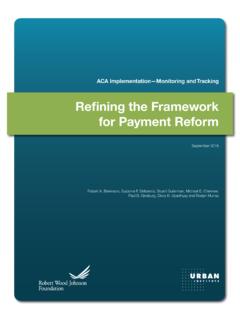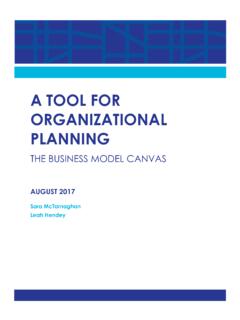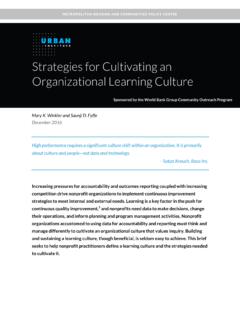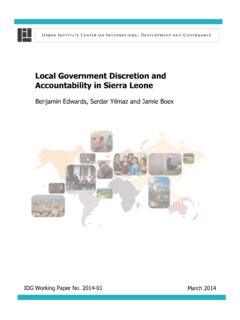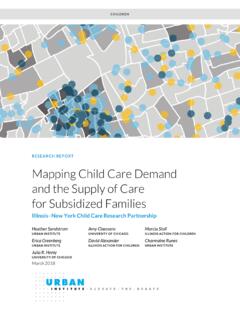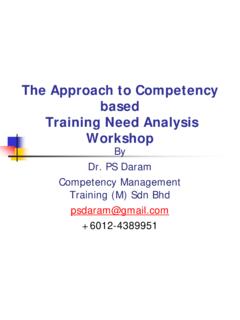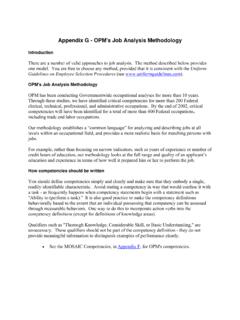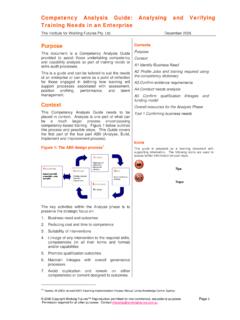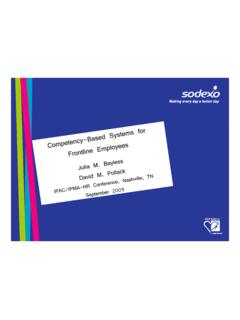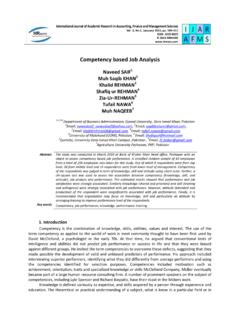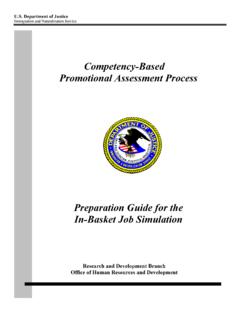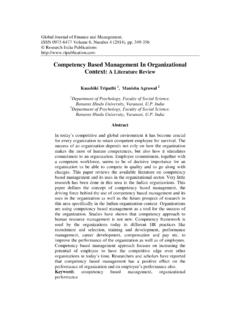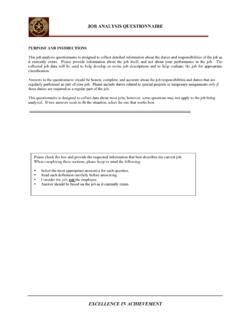Transcription of COMPETENCY -BASED OCCUPATIONAL FRAMEWORK FOR …
1 COMPETENCY -BASED OCCUPATIONAL FRAMEWORK FOR REGISTERED APPRENTICESHIP Cyber Security Support Technician ONET Code: RAPIDS Code: 2050CB Created: August 2017 Updated: December 2017 This project has been funded, either wholly or in part, with Federal funds from the Department of Labor, Employment and Training Administration under Contract Number DOL-ETA-15-C-0087. The contents of this publication do not necessarily reflect the views or policies of the Department of Labor, nor does mention of trade names, commercial products, or organizations imply endorsement of the same by the Government. For More Information, Contact: Diana Elliott, PhD, Senior Research Associate, Urban Institute: Robert Lerman, PhD, Institute Fellow, Urban Institute: II ACKNOWLEDGEMENTS ABOUT THE URBAN INSTITUTE The nonprofit Urban Institute is dedicated to elevating the debate on social and economic policy.
2 For nearly five decades, Urban scholars have conducted research and offered evidence -BASED solutions that improve lives and strengthen communities across a rapidly urbanizing world. Their objective research helps expand opportunities for all, reduce hardship among the most vulnerable, and strengthen the effectiveness of the public sector. Acknowledgments We thank Diane Auer Jones for her expertise and contributions to this document. CONTENTS III Contents COMPETENCY -BASED OCCUPATIONAL Frameworks 1 Components of the COMPETENCY -BASED OCCUPATIONAL FRAMEWORK 2 Using the COMPETENCY -BASED OCCUPATIONAL FRAMEWORK to Develop a Registered Apprenticeship Program 3 Cyber Security Support Technician OCCUPATIONAL Overview 4 OCCUPATIONAL Purpose and Context 4 Potential Job Titles 4 Attitudes and Behaviors 4 Apprenticeship Prerequisites 5 OCCUPATIONAL Pathways 5 Certifications.
3 Licensure and Other Credential Requirements 5 Job Functions 6 Stackable Programs 6 Options and Specializations 7 Levels 7 NICE FRAMEWORK Alignment 8 Work Process Schedule 11 Related Technical Instruction Plan 21 Cross Cutting Competencies 23 Detailed Job Functions 25 JOB FUNCTION 1: Assists in developing security policies and protocols; assists in enforcing company compliance with network security policies and protocols 25 JOB FUNCTION 2: Provides technical support to users or customers 26 JOB FUNCTION 3: Installs, configures, tests, operates, maintains and manages networks and their firewalls including hardware and software that permit sharing and transmission of information 30 JOB FUNCTION 4: Installs, configures, troubleshoots and maintains server configurations to ensure their confidentiality, integrity and availability; also manages accounts, firewalls, configuration, patch and vulnerability management.
4 Is responsible for access control, security configuration and administration 33 JOB FUNCTION 5: Configures tools and technologies to detect, mitigate and prevent potential threats 37 JOB FUNCTION 6: Assesses and mitigates system network, business continuity and related security risks and vulnerabilities 39 IV CONTENTS JOB FUNCTION 7: Reviews network utilization data to identify unusual patterns, suspicious activity or signs of potential threats 41 JOB FUNCTION 8: Responds to cyber intrusions and attacks and provides defensive strategies 43 COMPETENCY -BASED OCCUPATIONAL FRAMEWORKS 1 COMPETENCY -BASED OCCUPATIONAL Frameworks The Urban Institute, under contract by the Department of Labor, has worked with employers, subject matter experts, labor unions, trade associations, credentialing organizations and academics to develop COMPETENCY -BASED OCCUPATIONAL Frameworks (CBOF) for Registered Apprenticeship programs.
5 These frameworks defined the purpose of an occupation, the job functions that are carried out to fulfill that purpose, the competencies that enable the apprentice to execute those job functions well, and the performance criteria that define the specific knowledge, skills and personal attributes associated with high performance in the workplace. This organizational hierarchy Job Purpose Job Functions Competencies Performance Criteria is designed to illustrate that performing work well requires more than just acquiring discrete knowledge elements or developing a series of manual skills. To perform a job well, the employee must be able to assimilate knowledge and skills learned in various settings, recall and apply that information to the present situation, and carry out work activities using sound professional judgment, demonstrating an appropriate attitude or disposition, and achieving a level of speed and accuracy necessary to meet the employer s business need.
6 The table below compares the terminology of Functional analysis with that of traditional OCCUPATIONAL Task analysis to illustrate the important similarities and differences. While both identify the key technical elements of an occupation, Functional analysis includes the identification of behaviors, attributes and characteristics of workers necessary to meet an employer s expectations. FRAMEWORK Terminology Traditional Task analysis Terminology Job Function the work activities that are carried out to fulfill the job purpose Job Duties roles and responsibilities associated with an occupation COMPETENCY the actions an individual takes and the attitudes he/she displays to complete those activities Task a unit of work or set of activities needed to produce some result Performance Criteria the specific knowledge, skills, dispositions, attributes.
7 Speed and accuracy associated with meeting the employer s expectations Sub Task the independent actions taken to perform a unit of work or a work activity Although designed for use in COMPETENCY -BASED apprenticeship, these COMPETENCY -BASED OCCUPATIONAL Frameworks also support time -BASED apprenticeship by defining more clearly and precisely what the apprentice is expected to learn and do during the allocated time-period. 2 COMPETENCY -BASED OCCUPATIONAL FRAMEWORKS CBOFs are comprehensive in to encompass the full range of jobs that may be performed by individuals in the same occupation. As employers or sponsors develop their individual apprenticeship programs, they can extract from or add to the FRAMEWORK to meet their unique organizational needs.
8 Components of the COMPETENCY -BASED OCCUPATIONAL FRAMEWORK OCCUPATIONAL Overview: This section of the FRAMEWORK provides a description of the occupation including its purpose, the setting in which the job is performed and unique features of the occupation. Work Process Schedule: This section includes the job functions and competencies that would likely be included in an apprenticeship sponsor s application for registration. These frameworks provide a point of reference that has already been vetted by industry leaders so sponsors can develop new programs knowing that they will meet or exceed the consensus expectations of peers.
9 Sponsors maintain the ability to customize their programs to meet their unique needs, but omission of a significant number of job functions or competencies should raise questions about whether or not the program has correctly identified the occupation of interest. Cross-cutting Competencies: These competencies are common among all workers, and focus on the underlying knowledge, attitudes, personal attributes and interpersonal skills that are important regardless of the occupation. That said, while these competencies are important to all occupations, the relative importance of some versus others may change from one occupation to the next.
10 These relative differences are illustrated in this part of the CBOF and can be used to design pre-apprenticeship programs or design effective screening tools when recruiting apprentices to the program. Detailed Job Function analysis : This portion of the FRAMEWORK includes considerable detail and is designed to support curriculum designers and trainers in developing and administering the program. There is considerable detail in this section, which may be confusing to those seeking a more succinct, higher-level view of the program. For this reason, we recommend that the Work Process Schedule be the focus of program planning activities, leaving the detailed job function analysis sections to instructional designers as they engage in their development work.
